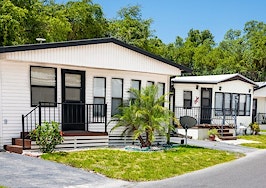The luxury real estate market has remained robust throughout the pandemic, with consumers purchasing second homes in relaxing locales, upgrading their primary digs for abodes with more outdoor space or catching a deal in urban centers that experienced a slight price drop as buyers went elsewhere.
Although 2021 provided a bit of price relief, Sotheby’s International Realty said buyers should gird themselves for fiercer competition. “A true buyer’s market isn’t likely, as people continue to move, and real estate is considered a hotter investment than ever,” the luxury franchisor’s latest luxury outlook report read. “Plus, there are two major issues keeping the market on the side of sellers: low inventory and material supply slowdowns.”
It added, “As such, most experts predict prices will increase throughout 2022, especially after the slower winter months.”
Here are four main things luxury homebuyers need to prepare for this year.
Stop waiting for home prices to fall
Like the rest of the market, the luxury sector returned to a seasonal pace in 2021 that saw home prices and bidding wars cool from a breakneck pace. Although homes are no longer garnering dozens of bids, Sotheby’s International Realty President and CEO Philip White said that doesn’t mean a buyer’s market is anywhere on the horizon.
“We’ve seen markets like Aspen, Colorado, more than double sales volume for our company,” White said in the report. “There are so many examples like this. We have an office in Destin, Florida, that’s done $2 billion in sales volume through November 2021, and it’s less than 100 agents in the panhandle of Florida. Park City, Utah, is a similar story.”
“I envision that it’s going to abate to some degree; it can’t continue to grow at the velocity it has,” he added. “But people are still moving. I still hear about multiple bids.”
From June to November 2021, listing prices for homes in the top 10 percent of the market in the United States were up nearly 20 percent year over year, the report said. Although rising mortgage rates and inflation will make the weight of price growth heavier, SIR said affluent buyers are still betting on the long-term benefits of homeownership — even if it costs more in the short term.
“If you look over the course of decades and centuries, luxury real estate — with all its ups and downs — has held value and even grown in value,” UBS Wealth Management Head of Real Estate and Financials Jonathan Woloshin told Sotheby’s.
SIR Chief Marketing Officer Brad Nelson told Inman only a 2008-esque financial event could tip the scales from a sellers’ market to a buyers’ market, but the consequences of that event wouldn’t be worth a dip in home prices.
“The consequences of an unforeseen macro event, like the global financial crisis of 2007-2008, would be far more devastating than lowering housing prices and isn’t something I wish for,” he said. “Today’s appreciating prices are the new normal, and in fact, buyers should be prepared for prices to continue to rise.”
“A recent report from Goldman Sachs predicts that housing prices in the U.S. will increase another 16 percent by the end of 2022,” he said.
Get creative with your offers
Despite their access to more financial capital than the average buyer, several Sotheby’s affiliates said luxury homebuyers are also opting to exit bidding wars rather than blow their budgets by five or six figures.
“This past spring and summer, homes would go on the market and within three days have 30 offers, with prices going almost $100,000 over asking,” Nashville-based managing broker Jenny Telwar said in the report. “Buyers have been burned out by that experience a little bit. And not every buyer has the capability to throw so much cash at [a deal] and to waive all contingencies.”
International buyers are partially responsible for the additional crunch, as loosened COVID-19 protections make it easier to travel to the U.S. and view properties. The continued push toward remote or hybrid work has also provided international buyers with the freedom to split their time between multiple countries.
“People will begin to move around the world for work, which means demand will inevitably increase,” UK-based managing director Guy Bradshaw said in the report.
Although foreign buyers are planting roots all over the country, New York City, Los Angeles and San Francisco continue to be prime choices due to their high cultural capital.
“The most recent Wealth-X report found that New York City was still the number one city in the world, with the most ultra-high-net-worth households in 2020,” Manhattan-based associate broker Wendy Arriz told Sotheby’s. “People love the city, and they want to be here for the culture and the energy.”
Nelson said SIR’s affiliates are helping buyers navigate the market with data, which can help them make smarter bids that address homeseller needs beyond extra cash.
“This increased demand, coupled with rising interest rates, encourages a buyer to purchase sooner rather than later,” Nelson said. “I recommend that buyers discuss the risks and potential benefits of waiving inspection contingencies or offering flexibility with closing dates or rent-back provisions.”
“These terms, aside from your price, may be very attractive to a seller who is processing their own emotional and logistical realities of moving,” he added.
Add luxury condos to your list of potential abodes
As with every other real estate segment, the luxury market is suffering from a major imbalance between supply and demand. Second-home and vacation markets have been the hardest hit, as vacation-home sales soared 57.2 percent year over year during the first quarter of 2021.
“The demand in Hawaii in the second-home market has not died down. The sales numbers have slowed down, though, as a direct response to the record-setting low inventory,” Hawaii-based principal broker Ryan MacLaughlin said in the report. “We haven’t seen this kind of inventory drought in 40 years.”
He added, “Yet the demand coming from West Coast buyers is still very much there. The price point on every transaction is continually going up, while the amount of trades per month are down.”
Boosting housing stats in the luxury market have been difficult, the report explained, as already-high material costs skyrocket to unseen levels due to supply chain slowdowns and labor shortages. For example, a home that would’ve cost $12 million to build before the pandemic will now cost $13 million to build.
“Every part of a house is more expensive today,” White explained. “It’s impacting new-home construction more than anything. We hear the most about lumber, but it’s everything. And that’s pushing up the average sales price.”
Beyond additional material costs, Nelson told Inman buying patterns and zoning restrictions make closing the inventory gap for affluent buyers more onerous than closing the gap for everyday buyers.
“Bridging the supply and demand gap through new construction in the luxury sector is even more complicated than the housing market at large, as the affluent tend to ‘move in packs’ and often prefer to live in communities – whether that is a major city like London or a resort such as Aspen, where it’s impossible to create more land for development,” he explained.
The solution lies in the development of luxury condominiums that provide a wide variety of services that make it easier for homebuyers to eschew single-family homes for multi-family living.
“As a result, the only real solution is to increase density, namely through the development of luxury condominiums, often on ‘infill’ sites. This requires zoning flexibility and can take years, if not decades, to assemble and build. It’s not a quick process,” he explained. “Thankfully, developers recognize that serviced luxury condominiums are particularly attractive to retirees and have been planning for a pending shift of boomers that will be looking to downsize.”
“Projects currently under construction, like The Mill District in the popular California Wine Country, couldn’t be coming at a better time,” he added.
Forget the suburbs — move to the exurbs
In addition to considering condo living, Sotheby’s International Realty’s report said luxury buyers are skipping the suburbs for the exurbs — areas well beyond the suburbs that offer access to urban amenities within a one- to two-hour drive.
“We’re seeing the biggest growth in exurbs in Williamson County, consistently ranked among the 20 wealthiest counties in the U.S.,” Telwar, who is based in Nashville, said in the report. “It’s one of our most active markets.”
“This is where we’ve seen our craziest market — the houses selling in a day or a weekend with 30 offers, the $200,000-over-asking bids, and buyers waiving everything under the sun,” she added. “It’s like a faucet was turned on, and it’s never stopped gushing.”
In Texas, Austin-based broker-owner J. Kuper said tech workers who’ve flocked to the city for work opportunities have embraced Dripping Springs and Cedar Park, the city’s most popular exurbs. Home sales in those areas are up 21 percent annually — 5 percent more than the sales growth in Austin proper.
“[Corporations’ workforces are] completely happy to be part of the greater Austin community. They are OK with living 30 or 45 minutes from town and being a commuter,” Kuper said.
Nelson told Inman the move to hybrid work environments (e.g., a workweek that’s split between in-office and at-home work) has pushed homebuyers to embrace the exurbs since they don’t need to commute every day.
“For example, if you are based in New York City and will be required to be in the office 1 to 2 days per week, you may be more inclined to live full-time in the Hudson Valley and take Amtrak to the city as needed, even if it’s a two-hour commute each way, as opposed to living in a close-in suburb,” he said.
Over time, Nelson said, exurbs will start to mirror their suburban and urban counterparts with more amenities and entertainment options.
“These affluent buyers will bring their spending power to exurb communities, so expect new restaurants, boutique luxury hotels and gourmet markets to follow,” he explained. “At the very high end, buyers are also more likely to bring their ‘celebrity’ architects and interior designers with them, which may upgrade the ‘significance’ of housing inventory long-term.”













